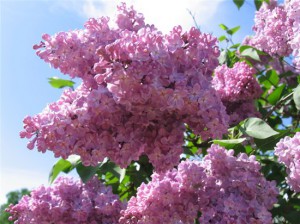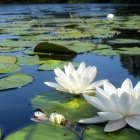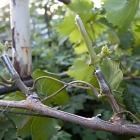Lilac It was always an indispensable to belong to the Russian manor, and then almost every home in the village, yard garden in the city. And until this afraid, the rustling flowering of lilac bushes adorns a country house and fills the soul with a special joy and excitement.
 What you need to do to flowering lilac It was really riveted? First of all, it takes a well-lit, sunny place. Lilac does not bloom in the shade. The soil should be well drained, deeply processed, with a neutral reaction. There are no places with high standing and flooded water. Otherwise, the culture is unpretentious: winter hardy, drought resistant, durable.
What you need to do to flowering lilac It was really riveted? First of all, it takes a well-lit, sunny place. Lilac does not bloom in the shade. The soil should be well drained, deeply processed, with a neutral reaction. There are no places with high standing and flooded water. Otherwise, the culture is unpretentious: winter hardy, drought resistant, durable.
Lilac easily forms root piglets, so when choosing grafted or core copies, it is more profitable to give preference to the kinseum. In the case of any damage, the frozen in harshless winter winters is precisely the korecological lilac grow well, being more durable and less expensive when leaving.
Easier total multiply lilac Survive shoots, although in the nurseries it is brew, cuttings, grains, seeds. At the grafted lilac requires annual repeated removal of wild ribbed of the lilac of the ordinary. If you miss this work, Lilac quickly, will become a fine-color wild lilac.
Maximum decorativeness Lilac reaches after 10-15 years, and well-kept adults and in 50 years old look great! Care is easy: these are loosening soil and feeding with a full fertilizer in spring and in mid-July, when lilac growth ends. When used: AVA fertilizers in spring are made only nitrogen fertilizers. Periodically, it is necessary to plug under the bushes.
Lilac disembark Early spring, before the dissolution of the kidneys, or in the second half of August - early September. Too elongated stalks and roots slightly shorten before planing. If the seedlings are grown with a closed root system, landing can be safely carried out at any time of the season. For 2-4-year-old seedlings, there are enough holes with a size of 50 × 60 cm. The pits are burst into the pits, put. Drainage layer 20 cm made of rubble, gravel chopped branches, crumbs, large sand.
Then fill the pit of fertile ground, mixed with a well-overwhelmed organic, add up to 2 kg of bone flour or 1-1.5 tbsp. P. Comprehensive fertilizer of long-term AVA (operates in the soil of 2-3 years), sprinkle its blue earth crystals and on a hilmik, placing the roots, install the plant. Usefully water with water and pour the roots of the earth, gently sealing it around the stems.
The root neck when landing should be 3-4 cm above the soil level so that after sealing and irrigations it is in the same place where it was before landing. The surface of the soil is inspired by a dry motor, an eliminated peat, ground for saving moisture. Adult bushes when landing are clinked to spicks to ensure stability during weather.
The following year after landing in the spring branch of lilac cut on the first pair of well-formed kidneys. Full gain and flowering are coming to the third to four year.
Flowering brushes cut off so as not to weaken plants by the formation of seeds. Even when Siren "matches", do not cease to make an annual trimming - this will provide good illuminated! whole crown. Remove the weak vessels, and the oldest stems in the spring cut up to 0.7-1 m of heights - and the thing you will notice that the lilac bush is replaceable! But I was rejected, and Krona became more painful.
Remember also that lilac floral pestles are laid only by the ends of well-developed annual shoots.
LITTLE TRICKS
• To longer save life bouquet of lilac, Its branches are better cut off early in the morning and immediately put in soft dilated water (the slice should be oblique and long). To mitigate into rigid tap water, it is possible to add citric acid (1/4 hours l per l l).
• If there is no possibility to immediately put the branches into the water, then before do it, refresh the slice under water with a sharp knife. You can dig a bark at the bottom of the stems, cut the stem along 4-5 cm or split the ends with a hammer before softening the fibers. All these techniques contribute to the best air flow in the vessels and prolong the life of the bouquet.
• Green shoots immediately separate from the blooming and put in the same vase - the evaporation of moisture will decrease.
• Never transfer cut lilac on the outdoor, without paving it "with head" into a soft paper.
• If the flowers have been applied, update the cut under water, wrap each branch into wet paper and immerse deep into the water with a temperature of 30-40 °. Strongly faded lilac branches can be tried to revive, immersing their lower treated ends in hot water for 15 minutes, and then putting room temperature in water.
• Lilac is better to put separately from other colors, for the excluded tulips, with which it is good to get along. Almost all the flowers with a strong aroma are overwhelming other plants.
• Nutritious and antiseptic solution for a bouquet may contain sugar or glucose (1 h. L), nitric acid silver (30 mg), calcium nitric acid (100 mg) per 1 liter of water. In the dachshop solution as needed to plot the dilated water.
• Lilac at night can be immersed in a cold water bath and put into "free swimming". In the morning, remove the branches out of the water, gently shake and put in the vase and let the drain of the water, then then place it on a bright place not on the direct sun without a draft.
• During the day, spray the lilac with cool water, that Tang extends the life and beauty of the bouquet.













 Start a discussion ...
Start a discussion ...